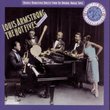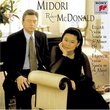| All Artists: Corigliano, Slatkin Title: John Corigliano - Of Rage and Remembrance ~ Symphony No.1 Members Wishing: 0 Total Copies: 3 Label: RCA Release Date: 9/17/1996 Album Type: Box set Genre: Classical Style: Number of Discs: 1 SwapaCD Credits: 1 UPCs: 090266845026, 089841815721 |
Search - Corigliano, Slatkin :: John Corigliano - Of Rage and Remembrance ~ Symphony No.1
 | Corigliano, Slatkin John Corigliano - Of Rage and Remembrance ~ Symphony No.1 Genre: Classical
Corigliano's most famous piece of music is the score to the film Altered States. Actually, all of his music kind of sounds like that-- alternating moments of poignant lyricism with explosions of rhythmic energy. The son ... more » ![header=[] body=[This CD is available to be requested as disc only.]](/images/attributes/disc.png?v=430e6b0a) ![header=[] body=[This CD is available to be requested with the disc and back insert.]](/images/attributes/disc_back.png?v=430e6b0a) ![header=[] body=[This CD is available to be requested with the disc and front insert.]](/images/attributes/disc_front.png?v=430e6b0a) ![header=[] body=[This CD is available to be requested with the disc, front and back inserts.]](/images/attributes/disc_front_back.png?v=430e6b0a) |
Larger Image |
CD DetailsSynopsis
Amazon.com Corigliano's most famous piece of music is the score to the film Altered States. Actually, all of his music kind of sounds like that-- alternating moments of poignant lyricism with explosions of rhythmic energy. The son of the former concertmaster of the New York Philharmonic, Corigliano literally grew up around the orchestra. So it's no surprise that his music is orchestrated with almost preternatural skill and brilliance. The First Symphony, inspired in part by the AIDS tragedy, is both an angry and a moving work. Leonard Slatkin plays it with the kind of manic energy the music demands, and the sound quality is terrific. --David Hurwitz Similarly Requested CDs
|
CD ReviewsThe best of two Joshua Saulle | Yonkers, NY USA | 06/29/2000 (5 out of 5 stars) "It is amazing (although perhaps not once you hear this music) that a modern symphony dealing with a difficult and controversial issue like AIDS should be given not one, but TWO excellent recordings by major American orchestras (the other being the premiere recording with the Chicago Symphony and Daniel Barenboim). But that simply indicates the importance and magnitude of this piece. It is certainly one of the best symphonies by an American composer, possibly one of the greatest symphonies of the 20th century. And of the two recordings available, this is to my mind the finest. Slatkin's direction is much tighter, giving the faster more rhythmic sections more clout, whereas in Barenboim's version, the orchestra lacked that precision. Some might prefer Barenboim's Mahleresque sound (like an orchestra so big it can barely hold itself together) but Slatkin achieves amazing power through precision without sacrificing the work's epic breadth. As an added bonus, there is the choral work 'Of Rage and Remembrance' which you should listen to only after hearing the symphony." Terrific absolute music too Mark McCue | Denver, CO USA | 07/24/2000 (4 out of 5 stars) "The extra-musical considerations of these works are interesting in and of themselves, but they are in no way necessary for an understanding and enjoyment of these considerable achievements by Corigliano.The composer has come some way from the piano concerto that Hilde Somer recorded in San Antonio back in the late '60s. There is the same rythmic pulse, the same intense desire to innovate while remaining accessible. There's more content in ideas and art surrounding those ideas that remind me strongly of Penderecki, Panufnik,Rieti, Nicholas Flagello and Creston without in the least way being derivative. Corigliano, truly an original voice, deserves to be in such distinguished company.My only concern is that these works have been pinned as so occasional that they might meet the fate of period pieces, much as some of the fine 1970s works of Gould, Carter, or Gregg Smith: we don't hear them any more because they've been so oft-discussed and fraught with situational association.The National Symphony has mended its somewhat slack ways proliferated under the Slavka regime. Antal Dorati would have been proud to hear the exquisite execution DC's superlative orchestra affords these affecting works." As powerful as your AIDS inolvement Czinczar | Southeast Michigan, USA | 06/16/2000 (4 out of 5 stars) "These works have to be viewed from two perspectives: as purely musical works and as personal reflections on the impact of AIDS. The Symphony is certainly strong enough to stand on its own merits. Are the struggles in it timeless enough to affect anyone in any age? I think so. It can transcend its programme if need be. The influence of Shostakovich on Corigliano is certainly evident here. So it's a winner from that perspective. And who better to conduct such a wrenching modern work than Slatkin? It should be noted that the recording of the Symphony is a LIVE, not STUDIO performance. What a concert it must have been! The tension in the audiance and orchestra is palpable. This live recording enhances the work's power. But what of the chaconne "Of Rage and Rememberance?" Can a work so completely wrapped up in the personal tragedy of AIDS speak to a listener like me, who has never suffered any AIDS losses? I must confess I felt disconected from it. All this angry mourning over people I'd never met or heard of. I felt as if I were intruding on someone else's tragedy. Maybe it won't affect you in the same way. Maybe its impact will be different for each person. You may find it heart-rending or just melodramatic. I don't know. I'll leave that decision to you."
|

 Track Listings (5) - Disc #1
Track Listings (5) - Disc #1








